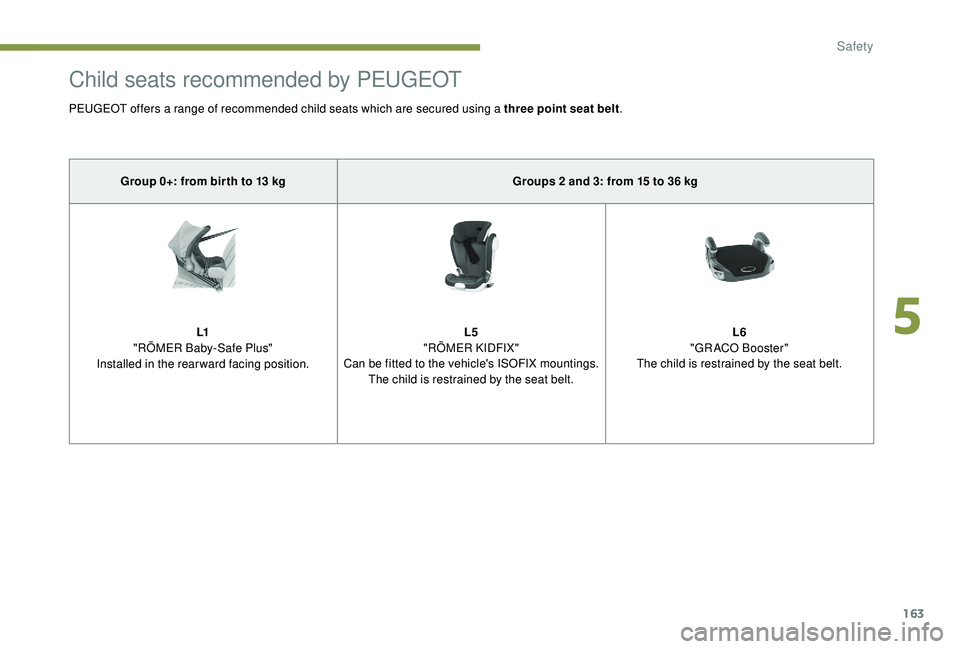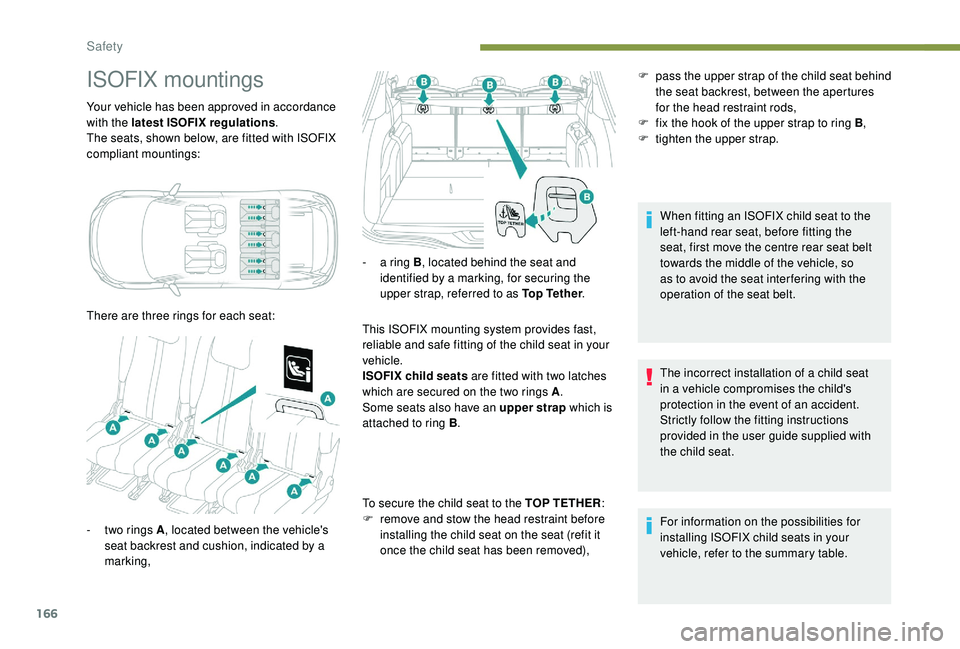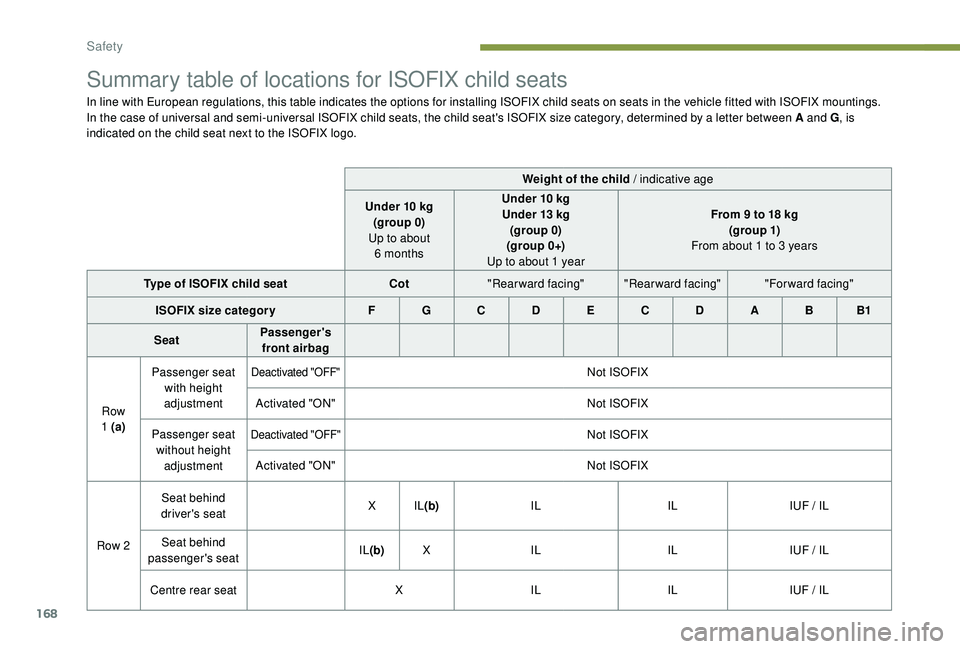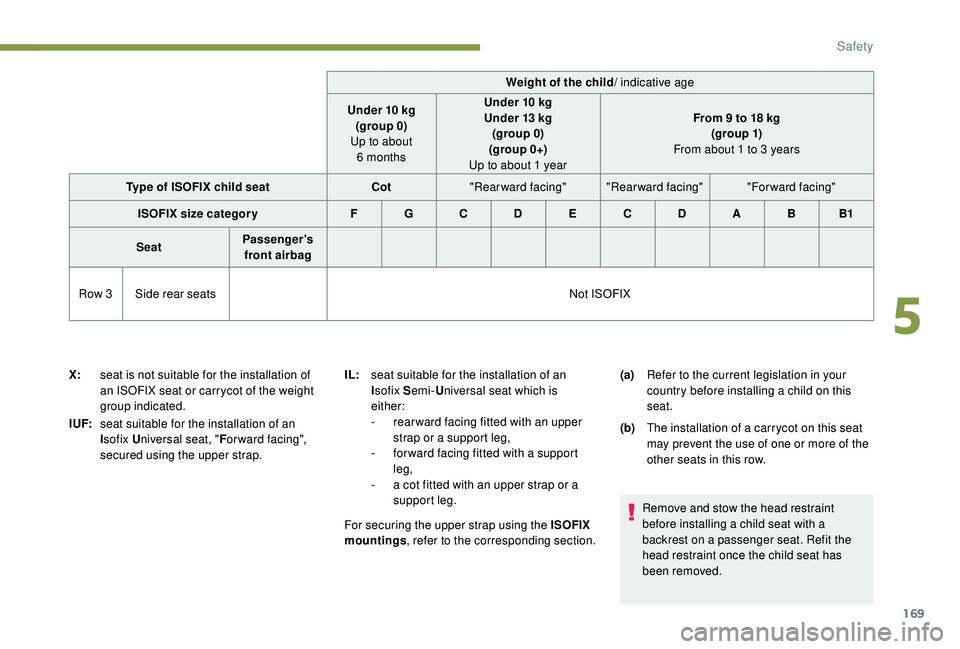2017 PEUGEOT 5008 isofix
[x] Cancel search: isofixPage 4 of 404

2
.
.
Head-up digital screen 8
I ndicator and warning lamps 1 2
Indicators
28
Manual test
3
4
Distance recorders
3
5
Lighting dimmer
3
5
Trip computer
3
6
Monochrome screen C
3
8
Touch screen
4
0
Remote control
4
9
K
eyless Entry and Starting
5
2
Back-up procedures
5
7
Anti-intrusion security
6
0
Central locking
6
0
Alarm
61
Doors
63
Boot
64
Hands-free tailgate
6
5
Electric windows
6
9
Panoramic opening sunroof
7
0Driving position
7
4
Front seats
7
6
Steering wheel adjustment
8
3
Mirrors 83
Second row seats
8
5
Third row seats
8
8
Seat modularity
9
2
i- Cockpit Amplify function
9
3
Heating and Ventilation 9 4
Manual air conditioning 9 6
Semi-automatic mono-zone air conditioning
9
7
Automatic dual-zone air conditioning
9
9
Recirculation of interior air
1
03
Front demist – defrost
1
03
Heated windscreen
1
04
Rear screen demist – defrost
1
04
Programmable heating
1
05
Front fittings
1
10
Courtesy lamps
1
16
Interior ambient lighting
1
17
Rear fittings
1
18
Boot fittings
1
20Exterior lighting control stalk
1
24
Direction indicators
1
27
Headlamp adjustment
1
28
Automatic illumination of headlamps
1
28
Automatic headlamp dipping
1
31
Cornering lighting
1
33
Wiper control stalk
1
34
Automatic rain sensitive wipers
1
36
General safety recommendations
1
38
Hazard warning lamps
1
39
H or n
13
9
Emergency or assistance call
1
39
Electronic stability control (ESC)
1
42
Advanced Grip Control
1
45
Hill Assist Descent Control
1
47
Seat belts
1
48
Airbags
1
53
Child seats
1
57
Deactivating the passenger front airbag
1
58
ISOFIX mountings and child seats
1
66
i-Size child seats
1
70
Manual child lock
1
73
Electric child lock
1
74
Over view
Dashboard instruments Ease of use and comfort
Safety
Access Lighting and visibility
Eco-driving
Contents
Page 159 of 404

157
General points relating to
child seats
* The legislation on carrying children is specific to each country. Consult the
legislation in force in your country.
Although one of the main criteria of PEUGEOT
when designing your vehicle, the safety of your
children also depends on you.
For maximum safety, please obser ve the
following recommendations:
-
I
n accordance with European regulations,
all children under the age of 12 or less
than one and a half metres tall must
travel in an approved child seat suited to
their weight and installed on a vehicle seat
fitted with a seat belt or ISOFIX mountings*.
-
S
tatistically, the safest seats in your
vehicle for carr ying children are the rear
seats.
-
A c
hild weighing less than 9 kg must
travel in the rear ward facing position
both in the front and in the rear. PEUGEOT recommends
that children
should travel on the rear seats of your
vehicle:
- "
rearward facing " up to the age of 3,
- "
forward facing " over the age of 3.
Child seat at the front
Refer to the current legislation in your country
before installing your child on this seat.
Rearward facing
When a rear ward facing child seat is installed
on the front passenger seat , adjust the
vehicle seat to the fully back and highest
position, with the backrest straightened.
The passenger's front airbag must be
deactivated. Otherwise, the child risks
being seriously injured or killed if the
airbag is deployed .
5
Safety
Page 165 of 404

163
Child seats recommended by PEUGEOT
PEUGEOT offers a range of recommended child seats which are secured using a three point seat belt.
Group 0+: from bir th to 13 kg Groups 2
and 3: from 15 to 36 kg
L1
"RÖMER Baby-Safe Plus"
Installed in the rearward facing position. L5
"RÖMER KIDFIX"
Can be fitted to the vehicle's ISOFIX mountings. The child is restrained by the seat belt. L6
"GRACO Booster"
The child is restrained by the seat belt.
5
Safety
Page 168 of 404

166
ISOFIX mountings
Your vehicle has been approved in accordance
with the latest ISOFIX regulations.
The seats, shown below, are fitted with ISOFIX
compliant mountings:
There are three rings for each seat: This ISOFIX mounting system provides fast,
reliable and safe fitting of the child seat in your
vehicle.
ISOFIX child seats are fitted with two latches
which are secured on the two rings A.
Some seats also have an upper strap which is
attached to ring B .
To secure the child seat to the TOP TETHER :
F
r
emove and stow the head restraint before
installing the child seat on the seat (refit it
once the child seat has been removed), When fitting an ISOFIX child seat to the
left-hand rear seat, before fitting the
seat, first move the centre rear seat belt
towards the middle of the vehicle, so
as to avoid the seat inter fering with the
operation of the seat belt.
The incorrect installation of a child seat
in a vehicle compromises the child's
protection in the event of an accident.
Strictly follow the fitting instructions
provided in the user guide supplied with
the child seat.
For information on the possibilities for
installing ISOFIX child seats in your
vehicle, refer to the summary table.
F
p
ass the upper strap of the child seat behind
the seat backrest, between the apertures
for the head restraint rods,
F
f
ix the hook of the upper strap to ring B,
F
t
ighten the upper strap.
-
t
wo rings A , located between the vehicle's
seat backrest and cushion, indicated by a
marking, -
a r
ing B, located behind the seat and
identified by a marking, for securing the
upper strap, referred to as Top Tether .
Safety
Page 169 of 404

167
ISOFIX child seats
recommended by
PEUGEOT
PEUGEOT offers a range of ISOFIX child seats
listed and type approved for your vehicle.Also consult the installation notes of the
child seat’s manufacturer to find out how
to install and remove the seat. "RÖMER Baby- Safe Plus and its ISOFIX
base"
(size category: E )
Group 0+: from bir th to 13 kg
Installed rearward facing using an ISOFIX base which is attached to rings A .
The base has a support leg, height-
adjustable, which rests on the vehicle's floor. This child seat can also be secured with a
seat belt. In this case, only the shell is used and attached to the vehicle seat using the three-point seat belt. "
RÖMER Duo Plus ISOFIX "
(size category: B1 )
Group 1: 9-18 kg
Installed only in the forward facing position.
Is attached to rings A and ring B , referred to
as TOP TETHER, using an upper strap.
Three seat body angles: sitting, reclining, lying down.
This child seat can also be used on seats not equipped with ISOFIX mountings. In
this case, it must be secured to the vehicle's seat by the three-point seat belt. Adjust the
position of the vehicle's front seat so that the child's feet are not touching the backrest.
5
Safety
Page 170 of 404

168
Summary table of locations for ISOFIX child seats
In line with European regulations, this table indicates the options for installing ISOFIX child seats on seats in the vehicle fitted with ISOFIX mountings.
In the case of universal and semi-universal ISOFIX child seats, the child seat's ISOFIX size category, determined by a letter between A and G, is
indicated on the child seat next to the ISOFIX logo.
Weight of the child / indicative age
Under 10
kg
(group 0)
Up to about 6
monthsUnder 10
kg
Under 13
kg
(group 0)
(group 0+)
Up to about 1
yearFrom 9
to 18 kg
(g ro up 1)
From about 1
to 3 years
Type of ISOFIX child seat Cot"Rearward facing" "Rearward facing" "Forward facing"
ISOFIX size categor y F G C D E C D A B B1
Seat Passenger's
front airbag
Row
1
(a) Passenger seat
with height
adjustment
Deactivated "OFF"Not ISOFIX
Activated "ON" Not ISOFIX
Passenger seat without height adjustment
Deactivated "OFF"Not ISOFIX
Activated "ON" Not ISOFIX
Row 2 Seat behind
driver's seat X
IL(b) IL ILIUF / IL
Seat behind
passenger's seat IL
(b) X IL ILIUF / IL
Centre rear seat XIL ILIUF / IL
Safety
Page 171 of 404

169
Weight of the child/ indicative age
Under 10
kg
(group 0)
Up to about 6
months Under 10
kg
Under 13
kg
(group 0)
(group 0+)
Up to about 1
year From 9
to 18 kg
(g ro up 1)
From about 1
to 3 years
Type of ISOFIX child seat Cot"Rearward facing" "Rearward facing" "Forward facing"
ISOFIX size categor y F G C D E C D A B B1
Seat Passenger's
front airbag
Row 3 Side rear seats Not ISOFIX
X: seat is not suitable for the installation of
an ISOFIX seat or carrycot of the weight
group indicated.
I UF: seat suitable for the installation of an
Isofix U niversal seat, " For ward facing",
secured using the upper strap. IL:
seat suitable for the installation of an
Isofix S emi-Universal seat which is
either:
-
r
ear ward facing fitted with an upper
strap or a support leg,
-
f
or ward facing fitted with a support
leg,
-
a c
ot fitted with an upper strap or a
support leg.
For securing the upper strap using the ISOFIX
mountings , refer to the corresponding section. (a)
Refer to the current legislation in your
country before installing a child on this
seat.
(b) The installation of a carrycot on this seat
may prevent the use of one or more of the
other seats in this row.
Remove and stow the head restraint
before installing a child seat with a
backrest on a passenger seat. Refit the
head restraint once the child seat has
been removed.
5
Safety
Page 172 of 404

170
Summary table of the locations for i-Size child seats
The i-Size child seats have two latches that engage on the two rings A.
The i-Size child seats also have:
-
e
ither an upper strap which is attached to the ring B,
-
o
r a support leg resting on the vehicle floor, compatible with the approved i-Size seat,
the role of which is to prevent the child seat from tipping for ward in the event of a collision.
For more information on ISOFIX mountings , refer to the corresponding section.
In accordance with the new European regulations, this table indicates the options for installing i-Size child seats on seats in the vehicle fitted with
ISOFIX mountings approved for i-Size.
Seating position Passenger's front airbagi- Size restraint system
Row 1
(a) Passenger seat Deactivated "OFF"
Not i-Size
Activated "ON" Not i-Size
Row 2 Seat behind driver's seat
i-U
Seat behind the front passenger's seat i-U
Centre rear seat i-U
Safety